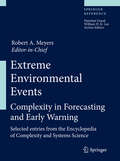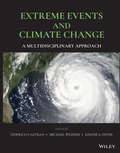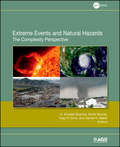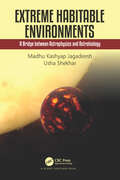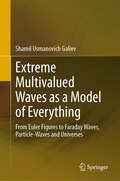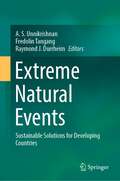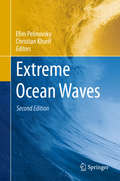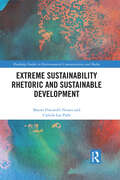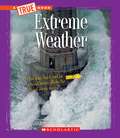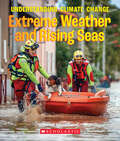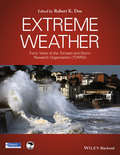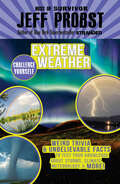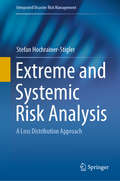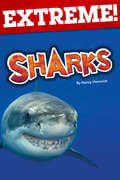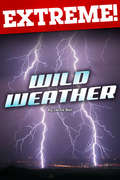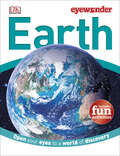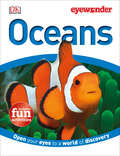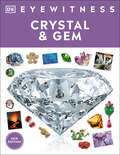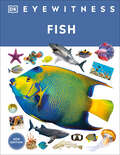- Table View
- List View
Extreme Environmental Events: Complexity in Forecasting and Early Warning
by Robert A. MeyersExtreme Environmental Events is an authoritative single source for understanding and applying the basic tenets of complexity and systems theory, as well as the tools and measures for analyzing complex systems, to the prediction, monitoring, and evaluation of major natural phenomena affecting life on earth. These phenomena are often highly destructive, and include earthquakes, tsunamis, volcanoes, climate change,, and weather. Early warning, damage, and the immediate response of human populations to these phenomena are also covered from the point of view of complexity and nonlinear systems. In 61 authoritative, state-of-the art articles, world experts in each field apply such tools and concepts as fractals, cellular automata, solitons game theory, network theory, and statistical physics to an understanding of these complex geophysical phenomena.
Extreme Events and Climate Change: A Multidisciplinary Approach (Geophysical Monograph Series)
by Federico Castillo Michael Wehner Dáithí A. StoneAn authoritative volume focusing on multidisciplinary methods to estimate the impacts of climate-related extreme events to society As the intensity and frequency of extreme events related to climate change continue to increase, there is an urgent need for clear and cohesive analysis that integrates both climatological and socioeconomic impacts. Extreme Events and Climate Change provides a timely, multidisciplinary examination of the impacts of extreme weather under a warming climate. Offering wide-ranging coverage of the methods and analysis that relate changes in extreme events to their societal impacts, this volume helps readers understand and overcome the methodological challenges associated with extreme event analysis. Contributions from leading experts from across disciplines describe the theoretical requirements for analyzing the complex interactions between meteorological phenomena and the resulting outcomes, discuss new approaches for analyzing the impacts of extreme events on society, and illustrate how empirical and theoretical concepts merge to form a unified plan that enables informed decision making. Throughout the text, innovative frameworks allow readers to find solutions to the modeling and statistical challenges encountered when analyzing extreme events. Designed for researchers and policy makers alike, this important resource: Discusses topics central to understanding how extreme weather changes as the climate warms Provides coverage of analysis methods that relate changes in extreme events to their societal impacts Reviews significant theoretical and modeling advances in the physical aspects of climate science Presents a comprehensive view of state of the science, including new ways of using data from different sources Extreme Events and Climate Change: A Multidisciplinary Approach is an indispensable volume for students, researchers, scientists, and practitioners in fields such as hazard and risk analysis, climate change, atmospheric and ocean sciences, hydrology, geography, agricultural science, and environmental and space science.
Extreme Events and Natural Hazards
by Vijay P. Dimri Daniel N. Baker A. Surjalal Sharma Armin BundePublished by the American Geophysical Union as part of the Geophysical Monograph Series, Volume 196.Extreme Events and Natural Hazards: The Complexity Perspective examines recent developments in complexity science that provide a new approach to understanding extreme events. This understanding is critical to the development of strategies for the prediction of natural hazards and mitigation of their adverse consequences. The volume is a comprehensive collection of current developments in the understanding of extreme events. The following critical areas are highlighted: understanding extreme events, natural hazard prediction and development of mitigation strategies, recent developments in complexity science, global change and how it relates to extreme events, and policy sciences and perspective. With its overarching theme, Extreme Events and Natural Hazards will be of interest and relevance to scientists interested in nonlinear geophysics, natural hazards, atmospheric science, hydrology, oceanography, tectonics, and space weather.
Extreme Habitable Environments: A Bridge between Astrophysics and Astrobiology
by Madhu Kashyap Jagadeesh Usha ShekharExtreme Habitable Environments is a book authored with the intention of providing introductory material suitable for those interested in learning about exoplanets. The focal point of this book is to expose its readers to the excitement in identifying exoplanets and exploring the possibility of life on them. This book offers structured content enriched with graphics, flow charts, images and worked examples that make reading and learning a delight. This book further serves as a hands-on perspective of the solar system and exoplanets. The first two chapters give a thorough insight into the solar system replete with the dynamics of star and planet formation. Exoplanets are introduced in the third chapter. Remaining chapters deal with various aspects of exoplanets, in a phased manner. Every chapter starts with an inspirational quote by a renowned personality. Content for every chapter is written in a down-to-earth style to facilitate readers' understanding and appreciation of the fundamental concepts. While some topics are basically descriptive, others start with a simple concept and progressively become more rigorous and detailed. Every effort has been made to make each chapter as complete as possible with a view of inciting curiosity in the minds of the readers and motivating them towards additional knowledge acquisition. Numerical exercises are included at the end of relevant chapters to help readers develop independent thinking, logical analysis and deductive skills. It is hoped that this book will cater to the needs of students desirous of pursuing research and a career in the field of Exoplanets.
Extreme Multivalued Waves as a Model of Everything: From Euler Figures to Faraday Waves, Particle-Waves and Universes
by Shamil Usmanovich GalievThe purpose of the book is a mathematical and experimental study of extreme, multivalued waves based on scalar field equations. It is known that Einstein tried to build a unified (interdisciplinary) field theory that would unite all interactions in Nature into a single system. The book uses this idea, supplemented by the idea that all fundamental interactions have a wave, resonant, nonlinear nature. The theoretical foundation of the book also consists of the results of Leonard Euler. Fundamental questions about the polysemy of Nature are considered. On this basis, various highly nonlinear wave processes are modeled, ranging from waves in resonators and ocean waves to descriptions of particle-waves, the origin of the Universe and data from double-slit experiments. Gravitational and inertial effects are associated with solutions of relativistic wave equations. According to the book, the unsolved nature of some fundamental problems in physics is explained by the nonlinear and resonant nature of the world around us, which exists in a non-smooth and inhomogeneous space-time. We do not know how strong the influence of multivalued wave processes on the Universe is. This book is the first attempt to assess this influence. At the same time, the extreme waves considered in this book may be applied to different technologies and systems ranging from the atomic scale to the cosmos. With this book, the author celebrates the 100th anniversary of the beginning of the development of quantum mechanics and modern cosmology.
Extreme Natural Events: Sustainable Solutions for Developing Countries
by A. S. Unnikrishnan Fredolin Tangang Raymond J. DurrheimThis book presents the challenges of developing countries to understand and manage the risks of extreme natural events. In the seventeen chapters presented, it brings together scientific communities from Ghana, India, Indonesia, Malaysia, Philippines, Sri Lanka, South Africa, and Venezuela to share their expertise in different aspects of managing extreme natural events, particularly those related to climate. It discusses how adaptation to these extreme natural events must be an integral part of national policy of the developing countries dealing with disaster mitigation and management.
Extreme Natural Hazards, Disaster Risks and Societal Implications
by Alik Ismail-Zadeh Jaime Urrutia Fucugauchi Andrzej Kijko Kuniyoshi Takeuchi Ilya Zaliapin Alik Ismail-Zadeh Jaime Urrutia Fucugauchi Andrzej Kijko Kuniyoshi TakeuchiThis book presents a unique, interdisciplinary approach to disaster risk research, combining cutting-edge natural science and social science methodologies. Bringing together leading scientists, policy makers and practitioners from around the world, it presents the risks of global hazards such as volcanoes, seismic events, landslides, hurricanes, precipitation floods and space weather, and provides real-world hazard case studies from Latin America, the Caribbean, Africa, the Middle East, Asia and the Pacific region. Avoiding complex mathematics, the authors provide insight into topics such as the vulnerability of society, disaster risk reduction policy, relations between disaster policy and climate change, adaptation to hazards, and (re)insurance approaches to extreme events. This is a key resource for academic researchers and graduate students in a wide range of disciplines linked to hazard and risk studies, including geophysics, volcanology, hydrology, atmospheric science, geomorphology, oceanography and remote sensing, and for professionals and policy makers working in disaster prevention and mitigation.
Extreme Ocean Waves
by Efim Pelinovsky Christian KharifThis revised and updated second edition details the vast progress that has been achieved in the understanding of the physical mechanisms of rogue wave phenomenon in recent years. The selected articles address such issues as the formation of rogue waves due to modulational instability of nonlinear wave field, physical and statistical properties of extreme ocean wave generation in deep water as well as in shallow water, various models of nonlinear water waves, special analysis of nonlinear resonances between water waves and the relation between in situ observations, experimental data and rogue wave theories. In addition, recent results on tsunami waves due to subaerial landslides are presented. This book is written for specialists in the fields of fluid mechanics, applied mathematics, nonlinear physics, physical oceanography and geophysics, and for students learning these subjects.
Extreme States of Matter in Strong Interaction Physics: An Introduction (Lecture Notes in Physics #841)
by Helmut SatzThis book is a course-tested primer on the thermodynamics of strongly interacting matter – a profound and challenging area of both theoretical and experimental modern physics. Analytical and numerical studies of statistical quantum chromodynamics provide the main theoretical tool, while in experiments, high-energy nuclear collisions are the key for extensive laboratory investigations. As such, the field straddles statistical, particle and nuclear physics, both conceptually and in the methods of investigation used. The book addresses, above all, the many young scientists starting their scientific research in this field, providing them with a general, self-contained introduction that highlights the basic concepts and ideas and explains why we do what we do. Much of the book focuses on equilibrium thermodynamics: first it presents simplified phenomenological pictures, leading to critical behavior in hadronic matter and to a quark-hadron phase transition. This is followed by elements of finite temperature lattice QCD and an exposition of the important results obtained through the computer simulation of the lattice formulation. It goes on to clarify the relationship between the resulting critical behavior due to symmetry breaking/restoration in QCD, before turning to the QCD phase diagram. The presentation of bulk equilibrium thermodyamics is completed by studying the properties of the quark-gluon plasma as a new state of strongly interacting matter. The final chapters of the book are devoted to more specific topics that arise when nuclear collisions are considered as a tool for the experimental study of QCD thermodynamics. This second edition includes a new chapter on the hydrodynamic evolution of the medium produced in nuclear collisions. Since the study of flow for strongly interacting fluids has gained ever-increasing importance over the years, it is dealt with it in some detail, including comments on gauge/gravity duality. Moreover, other aspects of experimental studies are brought up to date, such as the search for critical behavior in multihadron production, the calibration of quarkonium production in nuclear collisions, and the relation between strangeness suppression and deconfinement.
Extreme Sustainability Rhetoric and Sustainable Development (Routledge Studies in Environmental Communication and Media)
by Mauro Fracarolli Nunes Camila Lee ParkThis book considers the nature, causes, and consequences of extreme pro- and anti-sustainability rhetoric, exploring how and why the expressions of radical views on sustainability-related themes may prevent real sustainable development. Following a thorough introduction on sustainability rhetoric, on dialogue, and on the role played by ideologies in the building of environmental beliefs, Fracarolli Nunes and Lee Park examine positions and statements expressed or made by individuals, companies, governments, and NGOs in the last decades. The outcomes of these considerations lead to the classification of expressions in different categories of sustainability rhetoric, laying the groundwork for the development of a ‘sustainability spectrum’: a metric for the level of radicalization of sustainability positions, which ranges from apocalyptic views to ultimate denial. Through the combination of historical perspectives, theoretical frameworks, and conceptual developments, this book provides a foundation for a more informed and productive dialogue between radically opposing views on sustainability issues. This volume will be of great interest to students, scholars, and practitioners researching and working in the areas of environmental communication and media, environmental politics, and sustainable development.
Extreme Weather (True Books)
by Ann O. SquireEvery day, the world's scientists are working to solve some of the most thrilling mysteries on Earth. This True Book series highlights some of the incredible ways that scientists search for answers to our biggest questions. Readers will discover how scientists conduct experiments in extreme situations, how some of the world's most advanced laboratories have benefitted scientists, and much, much more. Most days, you probably don't think too much about the weather. You might wear a coat on a cold day or carry an umbrella when it rains. But weather can be unpredictable. Downpours can flood entire cities, raging winds can knock down buildings, and huge piles of snow can block roads. Readers will find out how scientists study some of the most extreme weather on Earth, from violent tornadoes to deadly hailstorms. They will also learn about some of the most devastating weather events in history. Features: Engaging sidebars highlight some of history's most remarkable scientific discoveries Timelines illustrate the ways our knowledge of science has changed over time Glossaries explain difficult scientific terms in a way that makes them easy to understand Eye-catching images give readers an up-close look at scientific procedures
Extreme Weather Events and Human Health: International Case Studies
by Rais AkhtarThis edited book assesses the impacts of various extreme weather events on human health and development from a global perspective, and includes several case studies in various geographical regions around the globe. Covering all continents, it describes the impact of extreme weather conditions such as flash floods, heatwaves, cold waves, droughts, forest fires, strong winds and storms in both developing and developed countries. The contributing authors also investigate the spread of diseases and the risk to food security caused by drought and flooding. Further, the book discusses the economic damage resulting from natural disasters including hurricanes. It has been estimated that in 2017 natural disasters and climate change resulted in economic losses of 309 billion US dollars. Scientists also predict that if nothing is done to curb the effects of climate change, in Europe the death toll due to weather disasters could rise 50-fold by the end of the 21st century, with extreme heat alone causing more than 150,000 deaths a year, as the report on global warming of 1.5°C warns that China, Russia and Canada’s current climate policies would steer the world above a catastrophic 5°C of warming by the end of 2100. As such, the book highlights how the wellbeing of different populations is threatened by extreme events now and in the foreseeable future.
Extreme Weather and Rising Seas (A True Book (Relaunch))
by Karina HamalainenWhat is the difference between climate and weather? How does ice melting at the South Pole affect sea levels thousands of miles away?This book explains how climate change contributes to rising sea levels and hazards such as heat waves, droughts, and extra-powerful storms. Learn how scientists analyze these extreme events and predict how they might change in the future.Glaciers are melting. Summers are heating up. Sea levels are on the rise. Climate change is affecting every corner of our planet - and it's the subject of a lot of concern, activism, and debate. STEM meets current events in this new A True Book set that offers readers the chance to learn about the causes and effects of climate change, as well as how people around the world are reacting to it. Students will read about the history and scope of the problem, analyze the same kinds of evidence that scientists do, and come away with tools that will help them respond to this pressing global issue.This series covers Next Generation Science Standards core ideas including Weather and Climate, Human Impacts on Earth Systems, Conservation of Energy and Energy Transfer, and Biodiversity and Humans.
Extreme Weather: Forty Years of the Tornado and Storm Research Organisation (TORRO)
by Robert K. DoeThis book is about weather extremes in the United Kingdom. It presents fascinating and detailed insights into tornadoes (supercell and non-supercell tornadoes, historical and contemporary case studies, frequency and spatial distributions, and unique data on extreme events); thunderstorms (epic event analysis and observing); hailstorms (intensity, distributions and frequency of high magnitude events); lightning (lightning as a hazard, impacts and injuries); ball lightning (definitions, impacts and case studies); flooding (historical and contemporary analysis, extreme rainfall and flash flooding); snowfalls (heavy snowfall days and events). It also looks at researching weather extremes, provides guidance on performing post-storm site investigations and details what is involved in severe weather forecasting. It is written by members, directors and past and present Heads of the research group the Tornado and Storm Research Organisation (TORRO). With fifteen chapters thematically arranged, and data appendix including a new tornado map of the U.K., this book presents a wealth of information on meteorological extremes. This volume is aimed primarily at researchers in the field of meteorology and climatology, but will also be of interest to advanced undergraduate students taking relevant courses in this area.
Extreme Weather: Weird Trivia & Unbelievable Facts to Test Your Knowledge About Storms, Climate, (Challenge Yourself #4)
by Jeff ProbstCHALLENGE YOURSELF! A nature-based trivia series with vibrant visuals and fascinating facts. Discover the most extreme weather on earth!From Emmy-Award winning host of Survivor and New York Times bestselling author of Stranded, Jeff Probst comes a dynamic and graphic line of trivia books! Packed with full-color photos, fascinating facts and trivia, and great callouts from Jeff, this series is perfect for every kid looking to know the coolest, weirdest facts and trivia around! Challenge yourself to discover the world&’s most extreme weather--from hurricanes and tornadoes to blizzards, avalanches, and snow storms and much, much more!
Extreme and Systemic Risk Analysis: A Loss Distribution Approach (Integrated Disaster Risk Management)
by Stefan Hochrainer-StiglerThis book is about how extreme and systemic risk can be analyzed in an integrated way. Risk analysis is understood to include measurement, assessment as well as management aspects. Integration is understood as being able to perform risk analysis for extreme and systemic events simultaneously. The presented approach is based on Sklar's theorem, which states that a multivariate distribution can be separated into two parts – one describing the marginal distributions and the other describing the dependency between the distributions using a so-called copula. It is suggested to reinterpret Sklar's theorem from a system or network perspective, treating copulas as a network property and individual, including extreme, risk as elements within the network. In that way, extreme and systemic risk can be analyzed independently as well as jointly across several scales. The book is intended for a large audience, and all techniques presented are guided with examples and applications with a special focus on natural disaster events. Furthermore, an extensive literature and discussion of it are given in each chapter for the interested reader.
Extreme physics
by Jeff Colvin Jon LarsenMost matter in the Universe, from the deep interior of planets to the core of stars, is at high temperature or high pressure compared to the matter of our ordinary experience. This book offers a comprehensive introduction to the basic physical theory on matter at such extreme conditions and the mathematical modeling techniques involved in numerical simulations of its properties and behavior. Focusing on computational modeling, the book discusses topics such as the basic properties of dense plasmas; ionization physics; the physical mechanisms by which laser light is absorbed in matter; radiation transport in matter; the basics of hydrodynamics and shock-wave formation and propagation; and numerical simulation of radiation-hydrodynamics phenomenology. End-of-chapter exercises allow the reader to test their understanding of the material and introduce additional physics, making this an invaluable resource for researchers and graduate students in this broad and interdisciplinary area of physics.
Extreme: Sharks
by Nancy HonovichGo face-to-face with the world's most awesome predators! Extreme: Sharks is packed with incredible photos of the most fascinating creatures in the sea!
Extreme: Wild Weather
by Jackie BallExperience the most awesome power on Earth: wild weather! From destructive thunderstorms to devistating tornados, wild weather can appear out of nowhere and uproot trees, tear apart houses, and bring cities to a standstill. Extreme: Wild Weather is packed with dramatic photos and the insight you need to understand droughts, ice storms, tsunamis, and more.
Extremes in a Changing Climate
by Amir Aghakouchak David Easterling Kuolin Hsu Siegfried Schubert Soroosh SorooshianThis book provides a collection of the state-of-the-art methodologies and approaches suggested for detecting extremes, trend analysis, accounting for nonstationarities, and uncertainties associated with extreme value analysis in a changing climate. This volume is designed so that it can be used as the primary reference on the available methodologies for analysis of climate extremes. Furthermore, the book addresses current hydrometeorologic global data sets and their applications for global scale analysis of extremes. While the main objective is to deliver recent theoretical concepts, several case studies on extreme climate conditions are provided. Audience The book is suitable for teaching in graduate courses in the disciplines of Civil and Environmental Engineering, Earth System Science, Meteorology and Atmospheric Sciences.
Eye Wonder: Open Your Eyes to a World of Discovery (Eye Wonder)
by DKOpen your eyes to a world of discovery. Offering a new level of information through powerful visuals, the Eye Wonder reference series was specially developed for children ready for their first books about the natural world. Full-color photography is matched with clearly written text to build a foundation for advanced exploration and help show children a stunning new view of the world.
Eye Wonder: Open Your Eyes to a World of Discovery (Eye Wonder)
by DKWhat's life like under the sea? Curious children will love learning about the ocean and discovering what life is like in the depths of the ocean. Eye Wonder: Oceans is packed with pictures to make learning about the ocean fun and interesting and to keep visual learners engaged. Through the activities and pictures in Eye Wonder: Oceans, your junior oceanographer can visit coral reefs and kelp forests, meet a host of sea creatures ranging from sharks to seals to jellyfish, and learn how sea creatures survive in their watery world. We've added fun new activities to Eye Wonder: Oceans to encourage engagement, learning, and knowledge retention. Visual learners and readers alike will love exploring and learning through Eye Wonder: Oceans. These books are designed to teach through pictures and a visual approach, encouraging curiosity in young, school-age children. We've added games, activities, and quizzes to engage children even more — Eye Wonder: Oceans activities are designed to teach kids to both remember more of what they've learned, and learn to research when they want to know more, teaching general study skills as well as ocean-specific. Learn about science, history, and the natural world through beautiful photography and lively, age-appropriate text. The Eye Wonder series organizes information in a way that's easy to search, easy to read, and easy to learn.
Eye of the Storm: NASA, Drones, and the Race to Crack the Hurricane Code
by Amy CherrixTen million Americans live in hurricane danger zones, but how do we know if or when to evacuate? We must predict both when a storm will strike and how strong it will be. A daring NASA earth science mission may have finally found a way to crack this hurricane code.Dr. Scott Braun is the principal investigator for the Hurricane and Severe Storm Sentinel mission (HS3), which flies repurposed military drone over hurricanes so that scientists can gather data. But the stakes are high and time is running out.In the first Scientists in the Field book entirely about weather, meet the NASA team on the cutting edge of meteorological field science.
Eyewitness Crystal and Gem (DK Eyewitness)
by DKFrom the rarest crystal to the most common stone, gems from around the world are revealed in dazzling detail in this illustrated guide. Become an eyewitness to the many different varieties of crystals and gems in this picture-led reference guide that will take you on a visual tour of the world of precious stones. Children will be mesmerized by the many uses of rocks like quartz and understanding crystals – from dazzling jewellery to diamond cutting tools and the silicon chip in their phone.This illustrated guide for kids aged 9+ reveals what exactly crystals and gems are, how they&’re formed, how to identify them, and how they can be used in everything from microchips to jewelry making.Throughout the pages of this newly-revised book on precious stones, you can expect to find: - A fresh new look; new photographs, updated information, and a new &“eyewitness&” feature.- Amazing facts, updated diagrams, statistics, and timelines.- Brand new eyewitness accounts from experts in the field.Eyewitness Crystal & Gem features striking full-color photographs of beautiful stones, including pearl and shell, jet and amber, quartz crystals, precious metals gemstones and much more! In this guide, curious children can find the answers to questions like, how can a rough diamond become a show-stopping centerpiece? Where does labradorite get its colors? Why are there quartz crystals in clocks and watches? How can crystals be grown in a laboratory? So, what&’s new? Part of DK&’s best-selling Eyewitness series, this popular title has been reinvigorated for the next generation of information-seekers and stay-at-home explorers, with a fresh new look, up to 20 percent new images, including photography and updated diagrams, updated information, and a new &“eyewitness&” feature with fascinating first-hand accounts from experts in the field.Explore the series!Globally, the Eyewitness series has sold more than 50 million copies over 30 years. Travel through the solar system with Eyewitness Space, discover the incredible world of creepy-crawlies in Eyewitness Insect, or take a trip aboard the most famous ship in history with Eyewitness Titanic.
Eyewitness Fish (DK Eyewitness)
by DKDive into a watery world where many wonderful fish of all shapes and sizes swim, in rivers, lakes, and oceans.Become an eyewitness to the fascinating world of fish, in this picture-led reference guide that will take you on a visual tour of the many different types of species and the ecosystems they live in. Children will be mesmerized by striking color photographs of tropical fish, eels, seahorses, and more, with a unique "eyewitness" view of the natural history of fish, how they behave, and how they survive. This unique, beautifully illustrated guide reveals the lethal jaws of a piranha, a porcupine fish "puffing up", how a dogfish swims, growth rings on a fish scale, what a fish looked like 400 million years ago, and a fish with legs! Using striking full-color photographs and illustrations, discover how a school stays together, why some fish swim upside down, how a stingray stings, and why fish need water to breathe, and much more.Throughout the pages of this newly-revised book on fish, you can expect to find: - A fresh new look, new photographs, updated information, and a new &“eyewitness&” feature- Amazing facts, diagrams, statistics, and timelines- Brand new eyewitness accounts from experts in the fieldEyewitness Fish introduces the ultimate guide to fish, from how they evolved to their weird andwonderful habits. Children can discover inside the egg of a fish, the great warriors of the sea and much more, through amazing facts, diagrams, and statistics to see them as never before. This all-emcompassing fish guide is a must-have for curious children aged 9+ with a thirst for learning, as well as teachers, parents and librarians.So, what&’s new? Part of DK&’s best-selling Eyewitness series, this popular title has been reinvigorated for the next generation of information-seekers and stay-at-home explorers, with a fresh new look, up to 20 percent new images, including photography and updated diagrams, updated information, and a new &“eyewitness&” feature with fascinating first-hand accounts from experts in the field.Explore the series!Globally, the Eyewitness series has sold more than 50 million copies over 30 years. Journey down the River Amazon and explore the rainforest with Eyewitness Amazon, learn how to combat climate change with Eyewitness Climate Change or take a trip aboard the most famous ship in history with Eyewitness Titanic.
